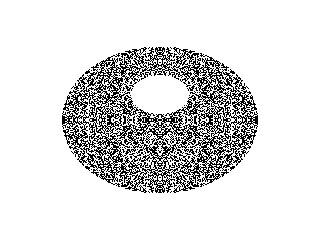我正在尝试编写一个简单的光线追踪器。最终图像应如下所示: 我已经阅读了相关内容,下面是我正在做的事情:
我已经阅读了相关内容,下面是我正在做的事情:
create an empty image (to fill each pixel, via ray tracing)
for each pixel [for each row, each column]
create the equation of the ray emanating from our pixel
trace() ray:
if ray intersects SPHERE
compute local shading (including shadow determination)
return color;
现在,场景数据是这样的:它在 (0,0,-3) 处设置了一个半径为 1 的灰色球体。它在原点设置了一个白色光源。
2
amb: 0.3 0.3 0.3
sphere
pos: 0.0 0.0 -3.0
rad: 1
dif: 0.3 0.3 0.3
spe: 0.5 0.5 0.5
shi: 1
light
pos: 0 0 0
col: 1 1 1
我的看起来很奇怪:

//check ray intersection with the sphere
boolean intersectsWithSphere(struct point rayPosition, struct point rayDirection, Sphere sp,float* t){
//float a = (rayDirection.x * rayDirection.x) + (rayDirection.y * rayDirection.y) +(rayDirection.z * rayDirection.z);
// value for a is 1 since rayDirection vector is normalized
double radius = sp.radius;
double xc = sp.position[0];
double yc =sp.position[1];
double zc =sp.position[2];
double xo = rayPosition.x;
double yo = rayPosition.y;
double zo = rayPosition.z;
double xd = rayDirection.x;
double yd = rayDirection.y;
double zd = rayDirection.z;
double b = 2 * ((xd*(xo-xc))+(yd*(yo-yc))+(zd*(zo-zc)));
double c = (xo-xc)*(xo-xc) + (yo-yc)*(yo-yc) + (zo-zc)*(zo-zc) - (radius * radius);
float D = b*b + (-4.0f)*c;
//ray does not intersect the sphere
if(D < 0 ){
return false;
}
D = sqrt(D);
float t0 = (-b - D)/2 ;
float t1 = (-b + D)/2;
//printf("D=%f",D);
//printf(" t0=%f",t0);
//printf(" t1=%f\n",t1);
if((t0 > 0) && (t1 > 0)){
*t = min(t0,t1);
return true;
}
else {
*t = 0;
return false;
}
下面是trace()函数:
unsigned char* trace(struct point rayPosition, struct point rayDirection, Sphere * totalspheres) {
struct point tempRayPosition = rayPosition;
struct point tempRayDirection = rayDirection;
float f=0;
float tnear = INFINITY;
boolean sphereIntersectionFound = false;
int sphereIndex = -1;
for(int i=0; i < num_spheres ; i++){
float t = INFINITY;
if(intersectsWithSphere(tempRayPosition,tempRayDirection,totalspheres[i],&t)){
if(t < tnear){
tnear = t;
sphereIntersectionFound = true;
sphereIndex = i;
}
}
}
if(sphereIndex < 0){
//printf("No interesection found\n");
mycolor[0] = 1;
mycolor[1] = 1;
mycolor[2] = 1;
return mycolor;
}
else {
Sphere sp = totalspheres[sphereIndex];
//intersection point
hitPoint[0].x = tempRayPosition.x + tempRayDirection.x * tnear;
hitPoint[0].y = tempRayPosition.y + tempRayDirection.y * tnear;
hitPoint[0].z = tempRayPosition.z + tempRayDirection.z * tnear;
//normal at the intersection point
normalAtHitPoint[0].x = (hitPoint[0].x - totalspheres[sphereIndex].position[0])/ totalspheres[sphereIndex].radius;
normalAtHitPoint[0].y = (hitPoint[0].y - totalspheres[sphereIndex].position[1])/ totalspheres[sphereIndex].radius;
normalAtHitPoint[0].z = (hitPoint[0].z - totalspheres[sphereIndex].position[2])/ totalspheres[sphereIndex].radius;
normalizedNormalAtHitPoint[0] = normalize(normalAtHitPoint[0]);
for(int j=0; j < num_lights ; j++) {
for(int k=0; k < num_spheres ; k++){
shadowRay[0].x = lights[j].position[0] - hitPoint[0].x;
shadowRay[0].y = lights[j].position[1] - hitPoint[0].y;
shadowRay[0].z = lights[j].position[2] - hitPoint[0].z;
normalizedShadowRay[0] = normalize(shadowRay[0]);
//R = 2 * ( N dot L) * N - L
reflectionRay[0].x = - 2 * dot(normalizedShadowRay[0],normalizedNormalAtHitPoint[0]) * normalizedNormalAtHitPoint[0].x +normalizedShadowRay[0].x;
reflectionRay[0].y = - 2 * dot(normalizedShadowRay[0],normalizedNormalAtHitPoint[0]) * normalizedNormalAtHitPoint[0].y +normalizedShadowRay[0].y;
reflectionRay[0].z = - 2 * dot(normalizedShadowRay[0],normalizedNormalAtHitPoint[0]) * normalizedNormalAtHitPoint[0].z +normalizedShadowRay[0].z;
normalizeReflectionRay[0] = normalize(reflectionRay[0]);
struct point temp;
temp.x = hitPoint[0].x + (shadowRay[0].x * 0.0001 );
temp.y = hitPoint[0].y + (shadowRay[0].y * 0.0001);
temp.z = hitPoint[0].z + (shadowRay[0].z * 0.0001);
struct point ntemp = normalize(temp);
float f=0;
struct point tempHitPoint;
tempHitPoint.x = hitPoint[0].x + 0.001;
tempHitPoint.y = hitPoint[0].y + 0.001;
tempHitPoint.z = hitPoint[0].z + 0.001;
if(intersectsWithSphere(hitPoint[0],ntemp,totalspheres[k],&f)){
// if(intersectsWithSphere(tempHitPoint,ntemp,totalspheres[k],&f)){
printf("In shadow\n");
float r = lights[j].color[0];
float g = lights[j].color[1];
float b = lights[j].color[2];
mycolor[0] = ambient_light[0] + r;
mycolor[1] = ambient_light[1] + g;
mycolor[2] = ambient_light[2] + b;
return mycolor;
} else {
// point is not is shadow , use Phong shading to determine the color of the point.
//I = lightColor * (kd * (L dot N) + ks * (R dot V) ^ sh)
//(for each color channel separately; note that if L dot N < 0, you should clamp L dot N to zero; same for R dot V)
float x = dot(normalizedShadowRay[0],normalizedNormalAtHitPoint[0]);
if(x < 0)
x = 0;
V[0].x = - rayDirection.x;
V[0].x = - rayDirection.y;
V[0].x = - rayDirection.z;
normalizedV[0] = normalize(V[0]);
float y = dot(normalizeReflectionRay[0],normalizedV[0]);
if(y < 0)
y = 0;
float ar = totalspheres[sphereIndex].color_diffuse[0] * x;
float br = totalspheres[sphereIndex].color_specular[0] * pow(y,totalspheres[sphereIndex].shininess);
float r = lights[j].color[0] * (ar+br);
//----------------------------------------------------------------------------------
float bg = totalspheres[sphereIndex].color_specular[1] * pow(y,totalspheres[sphereIndex].shininess);
float ag = totalspheres[sphereIndex].color_diffuse[1] * x;
float g = lights[j].color[1] * (ag+bg);
//----------------------------------------------------------------------------------
float bb = totalspheres[sphereIndex].color_specular[2] * pow(y,totalspheres[sphereIndex].shininess);
float ab = totalspheres[sphereIndex].color_diffuse[2] * x;
float b = lights[j].color[2] * (ab+bb);
mycolor[0] = r + ambient_light[0];
mycolor[1] = g + ambient_light[1];
mycolor[2] = b+ ambient_light[2];
return mycolor;
}
}
}
}
}
调用 trace() 的代码如下所示:
void draw_scene()
{
//Aspect Ratio
double a = WIDTH / HEIGHT;
double angel = tan(M_PI * 0.5 * fov/ 180);
ray[0].x = 0.0;
ray[0].y = 0.0;
ray[0].z = 0.0;
glClear(GL_COLOR_BUFFER_BIT | GL_DEPTH_BUFFER_BIT);
unsigned int x,y;
float sx, sy;
for(x=0;x < WIDTH;x++)
{
glPointSize(2.0);
glBegin(GL_POINTS);
for(y=0;y < HEIGHT;y++)
{
sx = (((x + 0.5) / WIDTH) * 2.0 ) - 1;
sy = (((y + 0.5) / HEIGHT) * 2.0 ) - 1;;
sx = sx * angel * a;
sy = sy * angel;
//set ray direction
ray[1].x = sx;
ray[1].y = sy;
ray[1].z = -1;
normalizedRayDirection[0] = normalize(ray[1]);
unsigned char* color = trace(ray[0],normalizedRayDirection[0],spheres);
unsigned char x1 = color[0] * 255;
unsigned char y1 = color[1] * 255;
unsigned char z1 = color[2] * 255;
plot_pixel(x,y,x1 %256,y1%256,z1%256);
}
glEnd();
glFlush();
}
}
代码/理解可能存在很多很多问题。
最佳答案
我没有花时间去理解你所有的代码,我绝对不是图形专家,但我相信你遇到的问题叫做“表面痤疮”。在这种情况下,它可能正在发生,因为您的阴影光线与对象本身相交。为了解决这个问题,我在代码中所做的是将 epsilon * hitPoint.normal 添加到阴影射线原点。这有效地将光线从您的物体移开一点,因此它们不会相交。
我为 epsilon 使用的值是 1.19209290 * 10^-7 的平方根,因为它是名为 EPSILON 的常量的平方根,即以我使用的特定语言定义。
关于c - 我的光线追踪器中的颗粒状球体,我们在Stack Overflow上找到一个类似的问题: https://stackoverflow.com/questions/20341141/